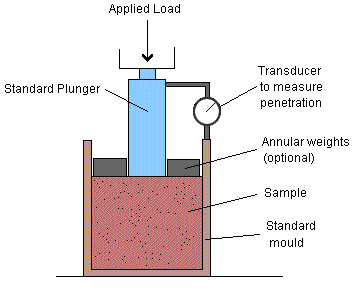Concept
The California Bearing Ratio test, or CBR test, is a laboratory (or in-situ) testing method to estimate the bearing value and the mechanical strength of highway sub-bases and subgrades.
Description and Procedure
The primary purpose of the California Bearing Ratio test is to determine the bearing capacity and the mechanical strenght of road sub-bases and subgrades. In this test in the laboratrory, the sample is prepared at at Proctor's maximum dry density or any other density at which the test is required.
A plunger of a satndard area is then pushed into the soil at a fixed rate of penetration, and the force requied to maintain that rate is measured. The CBR value is then defined as the ratio of the measured force to that required for similar penetration into a standard sample of crushed California limestone rock:
CBR=(F/Fs)x100%
where F is the measured force and Fs is the force required for similar penetration into a standard sample. Higher values of CBR indicate harder surface of material. Typical values of CBR rating for different materials are (Hear 1982) [1]:
| Type of soil | CBR range |
|---|---|
| Clay |
1-3
|
| Sandy clay |
4-7
|
| Well graded sand |
15-40
|
| Well graded sandy gravel |
20-60
|

Standard
- BS 1377-1: 1990 Methods of test for soils for civil engineering purposes. General requirements and sample preparation Link
- ASTM D1883 procedure07e2 Standard Test Method for CBR (California Bearing Ratio) of Laboratory-Compacted Soils Link
References - External Links
- Head, K. H., 1982, Manual of soil laboratory testing, Vol 2, Pentech Press, ISBN 0-7273-1305-3
